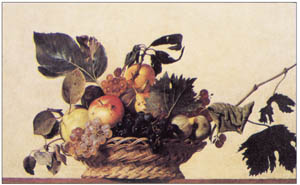Frutta Caravaggio

Poster Caravaggio Frutta - cm 120x90
| Codice | Dimensioni in cm | Grammatura per mq | цена € |
Q.ty ordine |
||
|---|---|---|---|---|---|---|
| Foglio | ||||||
Frutta Caravaggio -
Michelangelo Merisi da Caravaggio, (29 September 1571–18 July 1610) was an Italian artist active in Rome, Naples, Malta and Sicily between 1593 and 1610. His intensely emotional realism and dramatic use of lighting had a formative influence on the Baroque school of painting.
Trained in Milan under a master who had himself trained under Titian, Caravaggio moved to Rome in his early 20s. Huge new churches and palazzi were being built in Rome in the decades of the late 16th and early 17th Centuries, and paintings were needed to fill them. The Counter-Reformation Church searched for authentic religious art with which to counter the threat of Protestantism, and for this task the artificial conventions of Mannerism, which had ruled art for almost a century, no longer seemed adequate. Caravaggio's novelty was a radical naturalism which combined close physical observation with a dramatic, even theatrical, use of Tenebrism, the shift from light to dark with little intermediate value. He burst upon the Rome art scene in 1600 with the success of his first public commissions, the Martyrdom of Saint Matthew and Calling of Saint Matthew. Thereafter he never lacked for commissions or patrons, yet he handled his success atrociously. An early published notice on him, dating from 1604 and describing his lifestyle three years previously, tells how "after a fortnight's work he will swagger about for a month or two with a sword at his side and a servant following him, from one ball-court to the next, ever ready to engage in a fight or an argument, so that it is most awkward to get along with him."
In 1606 he killed a young man in a brawl and fled from Rome with a price on his head. In Malta in 1608 he was involved in another brawl, and yet another in Naples in 1609, possibly a deliberate attempt on his life by unidentified enemies. By the next year, after a relatively brief career, he was dead.
Famous (and notorious) while he lived, Caravaggio was forgotten almost immediately after his death, and it was only in the 20th century that his importance to the development of Western art was rediscovered. Despite this, his influence on the new Baroque style that eventually emerged from the ruins of Mannerism, was profound. It can be seen directly or indirectly in the work of Rubens, Jusepe de Ribera, Bernini, and Rembrandt, and artists in the following generation heavily under his influence were called the "Caravaggisti" or "Caravagesques", as well as Tenebrists or "Tenebrosi" ("shadowists"). Andre Berne-Joffroy, Paul Valéry's secretary, said of him: "What begins in the work of Caravaggio is, quite simply, modern painting."
